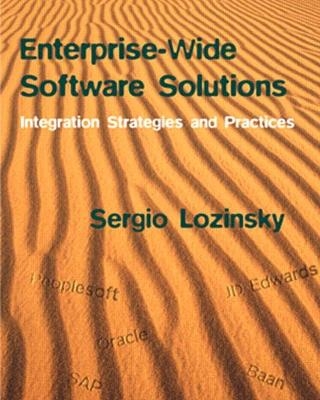
Enterprise-Wide Software Solutions
Addison Wesley (Verlag)
978-0-201-30971-3 (ISBN)
In an effort to become more flexible and competitive, companies are migrating from legacy systems to integrated business management package software products. These products represent the future for companies that need to streamline their business processes and improve the sharing of information in order to compete in the rapidly evolving business world. Yet adopting a package software solution is not a process to be taken lightly, and this critical change can represent a tremendous investment of time and resources. Most corporate officers charged with purchasing package software products are not experienced buyers, and there is very little information available to guide you through this process. Enterprise-Wide Software Solutions is the thorough tutorial and lasting reference you need to help you implement, use, and manage these powerful tools. This book provides a basis for planning and managing expectations among all relevant groups--corporate management, information technology staff, users, outside consultants, and the software vendor. Companies are investing significant amounts of money and time to implement business package solutions.
This book helps you reduce these costs and hours to more reasonable levels. Crucial topics--budgeting, project team organization, cost-justification, customization, outsourcing, reengineering, testing, training, and more--are covered in detail, allowing you to concentrate on the selection process, implementation strategy, and package software product that is best for your company. 0201309718B04062001
Sergio Lozinsky is a partner at Price Waterhouse, the leading audit and consulting services company. He is also a contributor to many information technology publications, and he has been working with numerous corporations during the last twenty years, helping them plan and implement information systems solutions as a tool to achieve better results and competitive market performance. 0201309718AB04062001
Foreword by Paul Wahl.
Preface.
Acknowledgements.
1. Making the Decision to Acquire a Software Package.
The Idea of Acquiring a Software Package.
Overcoming Resistance and Shifting Paradigms.
Is It Going to Be Very Expensive?
How Will the Company Benefit from the Acquisition?
Obtaining Everyone’s Commitment.
Planning the Selection Process.
2. Selecting the Most Appropriate Package.
There Is No Perfect Package.
Has the Technological Environment Already Been Predefined?
How Can the Selection Process Be Simplified?
How Can Products Be Compared without Mixing Apples and Oranges?
Arriving at a Consensus.
3. Getting Help with the Implementation of the Software Package.
Can the Company Develop the Implementation Alone?
How Can a Consulting Firm Help?
Will Hiring Consultants Be Expensive?
4. Contracting for the Software and the Training and Implementation Services.
Each Party Has a Role to Play in the Project.
The Role of the Package Vendor.
The Role of the Consultants.
The Role of the Company.
The Role of the Other Participants.
Contracts: Which Clauses Are Important?
The Role of the Integrator.
5. Organizing the Implementation Project.
Who within the Company Should Participate in the Project?
Who Should Be Assigned to the Project?
How Many People Should Be Assigned to the Project?
How Can the Project Be Structured?
Where Should the Project Team Work?
6. Implementation Methodology: A General Overview.
What Does a Software Implementation Project Look Like?
What Results Can the Company Expect?
Is the Appropriate Technological Environment Available?
Should the Company Take Advantage of the Situation and Engage in Reengineering?
It Is Not Going to Be a Bed of Roses.
7. Evaluating and Monitoring the Development of the Implementation Project.
Monitoring and Evaluating Project Development.
How Is the Work Monitored?
Assumptions: The Pillars of the Work Plan.
Monitoring the Project.
8. Phase 1: Understanding the Problem.
Looking at the Company and Its Future.
Current Systems and Processes.
Training Key Users.
In What Ways Is the Company Different from Other Companies?
Planning for the Conversion of the Initial Data.
9. Phase 2: Defining the Solutions.
Evaluating Whether the Company Should Go Forward.
Simulating and Prototyping: Understanding How the Package Is Going to Work.
Adapt the Package to the Company or the Company to the Package?
Managing Change.
Defining Package Parameters and Basic Tables.
Defining the Customization Required to Meet the Company’s Needs.
Requirements for Altering Existing Procedures.
Identifying Interfaces.
Levels of Access, Security, and Control.
10. Phase 3: Putting Hands to the Task.
Pumping Up the Adrenaline.
Customization, Interfaces, and Conversion Programs.
Implementing New Procedures and Controls.
Preparing the Processing Environment.
Keeping the Project on Track.
Testing the Whole System.
Training Future System Operators.
11. Phase 4: Making It Happen.
The Time Is Drawing Near.
Establishing an Operating Environment.
Data Conversion.
Finding the Best Approach to Safely Changing Systems.
How Long Should the Conversion Take?
User Support during the First Moments.
Making Identified Adjustments.
12. Now That the Package Is Working, What Should the Company Worry About?
Is It Possible to Improve the Use of the Package and Achieve Greater Benefits?
Simplifying.
Contacts with Other Companies That Use the Same Package.
13. My Dear Package Vendor: We're Counting on You.
What to Expect from the Package Vendor Now That the System Is Working.
Will the Company’s Package Vendor Survive in this Volatile Market?
14. Some Additional Ideas.
Lessons Learned through Experience.
Creating an Environment for Software Vendors to Install Their Product.
Interviewing Consultants When the Implementation Proposal Is Being Developed.
Requesting Names of Qualified Consultants from Other Companies.
Workshops and Meetings Outside the Company.
Evaluating the Software Package Documentation.
Requesting a Trial Period with the Product.
Setting Up an Internal Support Structure for the Software.
Do Not Underestimate the Importance of Managing the Project.
Conclusion.
Index. 0201309718T04062001
| Erscheint lt. Verlag | 21.5.1998 |
|---|---|
| Reihe/Serie | Addison-Wesley Information Technology Series |
| Verlagsort | Harlow |
| Sprache | englisch |
| Maße | 235 x 186 mm |
| Gewicht | 372 g |
| Themenwelt | Mathematik / Informatik ► Informatik ► Office Programme |
| ISBN-10 | 0-201-30971-8 / 0201309718 |
| ISBN-13 | 978-0-201-30971-3 / 9780201309713 |
| Zustand | Neuware |
| Informationen gemäß Produktsicherheitsverordnung (GPSR) | |
| Haben Sie eine Frage zum Produkt? |
aus dem Bereich


